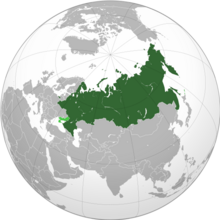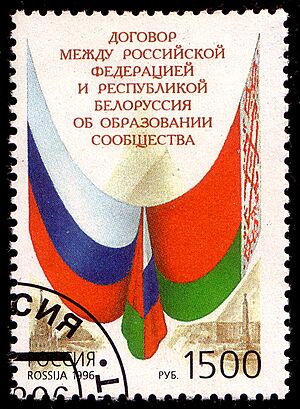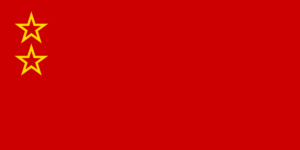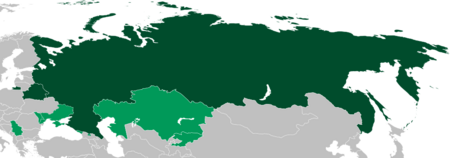Union State facts for kids
Quick facts for kids
Union State
|
|
|---|---|

The Union State, with disputed territories in light green
|
|
| Headquarters | 8/5 Staraya Square, Entrance 3, 103132 Moscow, Russia |
| Largest city | Moscow 55°45′N 37°37′E / 55.750°N 37.617°E |
| Official languages | |
| Demonym(s) | Russians, Belarusians |
| Type | Supranational union |
| Member states | |
| Government | Supranational union (currently), confederation (proposed) |
|
• Chairman of the Supreme State Council
|
|
|
• Chairman of the Council of Ministers
|
|
|
• General (State) Secretary
|
|
| Legislature | Supreme State Council and Council of Ministers |
| Supreme State Council | |
| Council of Ministers | |
| Formation | |
| 26 December 1991 | |
|
• Commonwealth of Belarus and Russia
|
2 April 1997 |
|
• Treaty on the Creation of a Union State of Russia and Belarus
|
8 December 1999 |
| Area | |
|
• Total
|
17,332,786 km2 (6,692,226 sq mi) |
| Population | |
|
• 2025 estimate
|
|
|
• Density
|
8.9/km2 (23.1/sq mi) |
| GDP (PPP) | 2025 estimate |
|
• Total
|
|
| GDP (nominal) | 2024 estimate |
|
• Total
|
|
| Currency | |
| Time zone | UTC+2 to +12 |
| Date format | dd.mm.yyyy |
| Driving side | right |
|
|
The Union State is a special partnership between Belarus and Russia. Its main goal is to bring the two countries closer together. This includes working together on their economies and defense.
Even though it was first planned to be a single country, both Belarus and Russia are still independent. The Union State is based on a treaty signed in 1997. Other countries can join if they want to. The Union State is led by the Supreme State Council and other groups. As of 2025, Alexander Lukashenko is the head of the Supreme State Council. The Union State mainly focuses on making their economies work together. They also work on taxes and defense.
Contents
How the Union State Started
The idea of a closer bond began on April 2, 1996. It was first called the Community of Belarus and Russia. This followed earlier agreements about Russia having military forces in Belarus.
The partnership became stronger on April 2, 1997. This is when the "Treaty on the Union between Belarus and Russia" was signed. At this time, its name changed to the Union of Belarus and Russia. More agreements were signed in December 1998. These aimed for even closer ties in politics, economy, and social life.
Leaders like Boris Yeltsin of Russia and Alexander Lukashenko of Belarus wanted to create this Union. They hoped to make their countries' political and economic systems more similar. The Treaty on the Creation of a Union State of Russia and Belarus was signed on December 8, 1999. The goal was to create a federation, like a single country. This would include a shared leader, laws, flag, army, and money. The treaty officially started on January 26, 2000.
How the Union State is Governed
The Treaty on the Creation of a Union State sets up the rules for how it works. It also created several important groups:
- Supreme State Council
- Council of Ministers
- Union Parliament
- Court of the Union
- Accounting Chamber
The Union State has power over certain areas. These include creating a single economy and common laws for trade. They also work on a shared money system, taxes, and defense. They have a common border policy too.
Some areas are shared between the Union State and its member countries. These include defense policy and making laws similar. They also work together on science, education, culture, and fighting crime. In all other areas, Belarus and Russia keep their full independence.
The Supreme State Council is the main ruling body. It includes the leaders of both countries, their governments, and members of their parliaments. Decisions are made with each country having one vote. The current head of the Council of Ministers is Mikhail Mishustin.
The Parliamentary Assembly of the Union has two parts. One part, the House of the Union, is currently active. It has 36 members from Russia and 36 from Belarus. They meet twice a year. The current president of the Parliamentary Assembly is Vyacheslav Volodin.
The Accounting Chamber checks how the Union State's money is spent. It has 11 members who are experts in finance.
Official Languages
The official languages of the Union State are the languages of Belarus and Russia. Russian is used for daily work in the Union State's offices.
What Has Happened So Far
After the Union State started, both countries seemed less excited about it. They even brought back customs checks at their border in 2001. These checks were removed again in 2010. There were also plans for a common currency, but this has been delayed many times.
Common Currency Plans
There have been many talks about having one currency for both countries. Belarusian President Alexander Lukashenko had hoped to introduce a common currency several times. However, this plan has been postponed year after year.
Citizenship and Travel
The Union State allows citizens of Russia and Belarus to be citizens of the Union. This means they can travel and live freely in either country. They can also work or study in the other country without special immigration steps. They still use their own national passports.
Military Cooperation
Russia and Belarus work together on military training. They have a group called the Regional Forces Group. This group helps them train and work together on defense. The military rules of Russia say that an attack on Belarus is an attack on the Union State. This means Russia can respond to such an attack. In March 2025, Russia and Belarus signed a treaty about mutual security guarantees.
Proposed Symbols
The Union State does not yet have its own flag or symbols. However, there have been ideas for them. One idea for a flag looks like the old Soviet Union flag, but with two gold stars. These stars would represent the two member countries.
A proposed coat of arms shows a double-headed eagle. This eagle would hold the symbols of both Russia and Belarus. A song called "Sovereign Union of Nations" has also been suggested as an unofficial anthem.
Other Countries Interested in Joining
Over the years, some other countries have shown interest in joining the Union State. These include:
- Abkhazia and South Ossetia: These regions have observer status in some meetings.
- Armenia: Some political groups in Armenia have wanted their country to join.
- Kazakhstan: Kazakhstan formed a customs union with Russia and Belarus in 2010. Its president joked about joining the Union State in 2023.
- Kyrgyzstan: Some groups in Kyrgyzstan have suggested joining.
- Moldova: In 2001, Moldova's president wanted to join. However, Moldova later became more interested in joining the European Union.
- Transnistria: This region, which is not recognized by many countries, has voted to join Russia.
- Ukraine: Ukraine's leaders have stated that Ukraine is an independent country. They have focused on joining the European Union and NATO.
- Serbia: In 1999, the Federal Republic of Yugoslavia (now Serbia) voted to join the Union State. Some Serbian politicians have expressed interest in closer ties.
Recent Developments
Talks about the Union State have continued. In 2007, Russian Prime Minister Viktor Zubkov said the Union State's budget would grow. This showed renewed interest.
In 2015, the focus shifted to the Eurasian Economic Union (EAEU). This is an economic group that includes Belarus, Russia, Kazakhstan, Armenia, and Kyrgyzstan. It is similar to the European Union's economic side. However, the Union State still handles political cooperation.
In November 2021, Russia and Belarus signed an agreement. This agreement aims for common policies on taxes, banking, and energy.
Impact of the 2022 Russian Invasion of Ukraine
After the 2022 Russian invasion of Ukraine, which involved Belarus, both countries faced international sanctions. Belarusian President Alexander Lukashenko supported Russia's actions. In March 2022, Russian Prime Minister Mikhail Mishustin and Belarusian Prime Minister Roman Golovchenko met. They discussed ways to protect their economies. Russia also lifted travel restrictions between the two countries. In July 2022, Russian President Vladimir Putin said the "unification" process was speeding up. This was to help with economic problems from the sanctions.
In October 2022, about 9,000 Russian soldiers arrived in Belarus. This was to create a "regional military grouping" for the Union State. Russian air forces also began patrolling the Union State's borders in Belarus.
Nuclear Deterrence in 2023
In May 2023, President Lukashenko said that other countries joining the Union State could get nuclear weapons. This statement came after Russia began moving some of its tactical nuclear weapons to Belarus.
25th Anniversary of the Treaty
On December 6, 2024, Russia and Belarus signed a new treaty. This treaty is about security guarantees within the Union State. It was signed around the 25th anniversary of the original Union State treaty.
See also
 In Spanish: Unión de Rusia y Bielorrusia para niños
In Spanish: Unión de Rusia y Bielorrusia para niños
- Commonwealth of Independent States
- Continental union
- Post-Soviet states
- Soviet Union
- Belarus–Russia relations
- Eurasian Economic Union
- European Single Market





